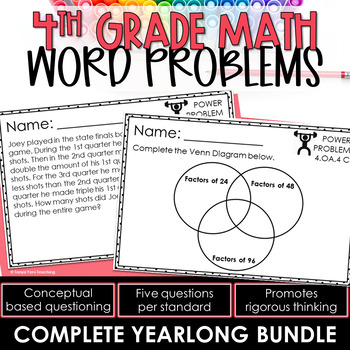4th Grade Math Word Problems | Math Spiral Review | Math Test Prep YEARLONG
- Zip

What educators are saying
Products in this Bundle (5)
Bonus
Also included in
- The POWER Math Ultimate Bundle is everything you need for a successful year of math instruction! The resources found in this bundle were designed with the philosophy in mind that math should be POWERful. POWER stands for purposeful opportunities with engagement and rigor. You and your students deserPrice $81.00Original Price $112.93Save $31.93
Description
This 4th grade math word problems contains 5 questions for each math standard. The questions are designed to help build conceptual understanding.
These questions can be used for whole class lesson starters, 4th grade math small groups, rotations, homework, math spiral review and math test prep.
Math word problems help students take math understanding to the next level. And these Power Problems were designed to do just that. Not all math word problems are created equally, it is important that word problems are realistic, relatable and written to promote higher order thinking. Power Problems do just that!
Combining a math word problem attack strategy with a good set of math word problems is a proven research-based strategy for deepening students’ mathematical understanding.
You can confidently use these word problems knowing that the questioning is targeting conceptual understanding. Students will need to use their reading and comprehension skills while also applying everything they have learned in math class.
Mastering the art of solving math word problems takes a lot of practice. With five questions for each standard, this set of Power Problems includes plenty of opportunities for practice.
How Power Problems will help your students:
- Display Math Applications in the Real World: Power Problems will show students how math concepts apply to real world situations and why math is so important.
- Develop Critical Thinking Skills: Some basic reasoning and elimination skills can lead to success with multiple choice questioning, but these word problems will require students to read carefully, gather relevant information, solve the math problem and think about whether or not their answer makes sense in the context of the problem.
- Application of Multiple Concepts: Power Problems will require students to pull apart problems, solve multiple pieces, put them back together into a logical solution.
- Build Creativity: Procedural math questions don’t build a great deal of creativity. In fact, with enough procedural questioning, students will just memorize the answers. But with Power Problems, there will be opportunities for students to create their own equation to solve the problem leading to several different approaches.
- Teacher Screening Aid: The best screeners of students are good teachers! And Power Problems are a great tool for teachers to visually see the mastery level of each of their students for each math standard or concept.
We have Power Problems for grades K-8! CLICK HERE to shop!
**DOWNLOAD THE BONUS FILE OF THIS BUNDLE TO ACCESS POWER PROBLEMS VIDEOS!!**
Standards & Topics Covered
Number and Operation in Base Ten
- 4.NBT.1 - Place Value Concepts
- 4.NBT.2 - Number Form, Word Form, Expanded Form, and Comparing of whole numbers
- 4.NBT.3 - Rounding multi-digit whole numbers
- 4.NBT.4 - Adding & Subtracting Whole Numbers
- 4.NBT.5 - Multiplying whole numbers
- 4.NBT.6 - Dividing whole numbers
Operations & Algebraic Thinking
- 4.OA.1 - Interpreting multiplication equations
- 4.OA.2 - Multiplying and dividing word problems
- 4.OA.3 - Solving multistep word problems, including interpreting remainders
- 4.OA.4 - Factors and multiples, Identifying prime and composite numbers within 100
- 4.OA.5 - Patterns
Number and Operation - Fractions
- 4.NF.1 - Equivalent fractions
- 4.NF.2 - Comparing fractions
- 4.NF.3 - Adding and subtracting fractions with like denominators, decomposing fractions, adding and subtracting mixed numbers with like denominators
- 4.NF. 4 - Multiplying a fraction by a whole number
- 4.NF.5 - Adding and subtracting fractions with denominators of 10 and 100
- 4.NF.6 - Decimal notation for fractions with denominators of 10 and 100
- 4.NF.7 - Comparing decimals to hundredths
Measurement and Data
- 4.MD.1 - Measurement and converting measurement with the customary and metric systems of length, weight, mass, liquid volume, and time
- 4.MD.2 - Solving measurement word problems
- 4.MD.3 - Area and perimeter of rectangles
- 4.MD.4 - Line plots
- 4.MD.5 - Angles within a circle
- 4.MD.6 - Measuring angles with a protractor
- 4.MD.7 - Additive angle measurement, decomposing angles
Geometry
- 4.G.1 - Identifying points, lines, line segments, rays, angles, perpendicular and parallel lines in 2D shapes
- 4.G.2 - Classifying 2D figures, types of triangles
- 4.G.3 - Symmetry






